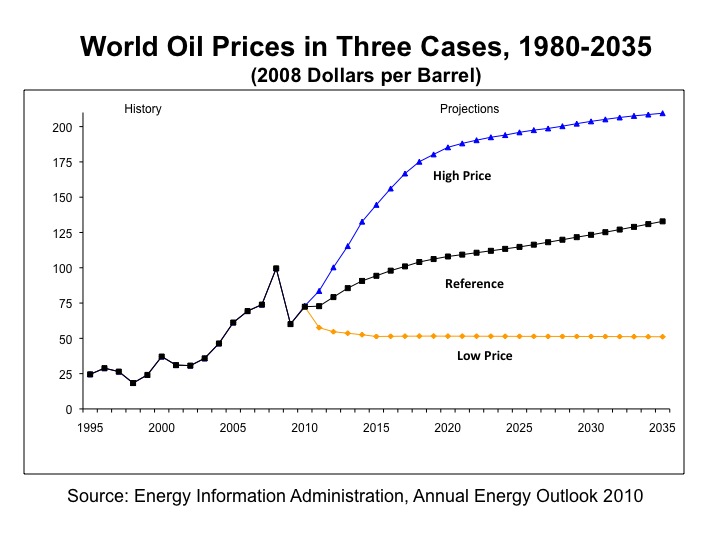November 25, 2014 at 3:52 pm

Image courtesy: IEA.org
Some interesting nuggets from IEA:
- Since 1990, the domestic transport sector has accounted for the largest share of total final energy consumption, more than 30%, in the 24 OECD countries.
- Within the sector, road transport dominates energy consumption, at 90% in 2011, as shown in this chart above based on the IEA energy efficiency indicators database.
- Further disaggregated data by segment and vehicle type indicate that consumption by passenger cars is a key driver (64%) for road transport, and thus for global energy consumption trends.
Click here to learn more.
November 9, 2010 at 5:16 pm
(Source: Ars Technica)

Each year, the International Energy Agency produces a report in which it considers trends in energy use and makes projections for the future. Usually, these reports simply take recent trends and project them forward, but this year’s is somewhat different: its author uses a mixture of current trends and the projected impact of countries’ pledges for reducing greenhouse gas emissions and subsidies for fossil fuels. This results in some eye-popping figures. Globally, we’re subsidizing fossil fuel use to the tune of hundreds of billions of dollars, at a rate of over five times the subsidies going to renewable energy. And our inaction on climate goals has tacked $1 trillion onto the cost of reaching them—in 2009 alone.
We’ll start with the subsidies. In 2009, the total subsidies were $312 billion, which may seem high until you hear the 2008 figure: $558 billion, boosted by countries’ responses to the high fossil fuel prices that year. Most of the subsidies went to help cut the costs of using oil and natural gas products; another substantial chunk went to electricity use.

The IEA factsheet also forecasts a steep rises in the primary energy demand (increases by 36% between 2008 and 2035, or 1.2% per year on average) oil prices. The cost of getting on track to meet the climate goal for 2030 has risen by about $1 trillioncompared with the estimated cost in last year’s Outlook. This is because much stronger efforts,costing considerably more, will be needed after 2020. In the 450 Scenario in this year’s Outlook, theadditional spending on low‑carbon energy technologies (business investment and consumerspending) amounts to nearly $18 trillion (in year- 2009 dollars) more than in the Current PoliciesScenario, in which no new policies are assumed, in the period 2010‑2035. It is around $13.5 trillionmore than in the New Policies Scenario.

Click here to read the entire Ars Technica argument and the IEA’s World Energy Outlook website.

March 4, 2009 at 12:44 pm
(Source: New York Times)
Amid a wave of government-led bailouts for car companies, a group of international agencies and motoring organizations called on Wednesday for car makers worldwide to reduce emissions.
“In confronting the economic recession this is a real opportunity for governments to combine support for the auto industry with measures to achieve environmental and energy policy goals,” said Nobua Tanaka, the executive director of the International Energy Agency.
 “Battery electric vehicles, plug-in hybrids and possibly hydrogen fuel cell vehicles are expected to become increasingly available in the near-to-medium term given recent improvements especially in batteries,” the 50-by-50 campaign noted in a leaflet. “However, these advanced technologies are not necessary to achieve the 50 percent potential described here, but could result in further CO2 reductions and oil savings if they succeed in achieving mass-market commercialization.”
“Battery electric vehicles, plug-in hybrids and possibly hydrogen fuel cell vehicles are expected to become increasingly available in the near-to-medium term given recent improvements especially in batteries,” the 50-by-50 campaign noted in a leaflet. “However, these advanced technologies are not necessary to achieve the 50 percent potential described here, but could result in further CO2 reductions and oil savings if they succeed in achieving mass-market commercialization.”
Click here to read the entire article.





 “Battery electric vehicles, plug-in hybrids and possibly hydrogen fuel cell vehicles are expected to become increasingly available in the near-to-medium term given recent improvements especially in batteries,” the 50-by-50 campaign noted in a
“Battery electric vehicles, plug-in hybrids and possibly hydrogen fuel cell vehicles are expected to become increasingly available in the near-to-medium term given recent improvements especially in batteries,” the 50-by-50 campaign noted in a